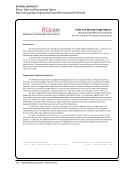144 · Representative Documents: Format Policies
Rutgers University
RUcore. Born Digital Still Images
http://odin.page2pixel.org/standards/latest/RUcoreStandards-BornDigitalPhotos.pdf
IBB • RUcore Preservation Standards • Born Digital Still Images Rev: 11/18/2010
Page 5 of 7
party software packages across Windows, Mac and linux platforms. Because of this, RUcore tends to
prefer capturing and preserving raw image files that have been converted to DNG, as these represented
minimally-processed image files in an open, well-documented format that preserves not only an
uncompressed digital image, but a wealth of associated technical metadata.
Recommended Born Digital Imaging Standards
Taking into account the aforementioned considerations, RUcore strives to adhere to the following
recommendations for born digital still image content:
Resolution Requirements:
• For entry-level consumer cameras: Minimum of 7.0 effective Megapixels (MP),
or 5.0 Megapixels if the camera has a “High Dynamic Range” (HDR) capability built-in.
o Most entry-level “point and shoot” cameras heavily process and compress photos taken
with them, introducing artifacts. Additionally, smaller imaging sensors in these cameras
contribute to sensor noise. The high minimum resolution is necessary to help overcome
these issues.
• For “Pro-Sumer,” bridge cameras, and professional dSLR cameras:
Minimum of 6.0 effective Megapixels (MP)
or 5.0 Megapixels if the camera has a “High Dynamic Range” (HDR) capability built-in.
o The resolution requirement for non-entry level cameras is lower because it is possible to
obtain unprocessed, uncompressed images from these cameras, generally yielding better
results even with less image information.
• Additional considerations for both classes of cameras:
o Use of “total” or “interpolated” pixel counts to meet the standard are not acceptable,
when the effective count is below the minimum.
o A camera will not qualify as preservation-grade if it uses interpolation to reach its
advertised resolution.
§ Example: A manufacturer advertises an extremely inexpensive digital camera
capable of producing 10MP images, however the fine print indicates the camera is
only equipped with a 3MP sensor. This camera is in fact interpolating a 3MP
image to 10MP, and is not acceptable for preservation purposes.
• Minimum 8 bits per channel (24-bit color)
o The camera should be capable of producing images using the sRGB palette.
• The equipment must be capable of producing images with pixel dimensions of at least 3,000
pixels on one side.
o Example dimensions: 3504 x 2336 3072 x 2902 3872 x 2592 and 3264 x 2448 are all
acceptable.
• The equipment must be EXIF compliant, version 2.0 or later.
o EXIF compliance ensures the camera will embed metadata into the image file that details
program modes, exposure settings, lens type, and other relevant information.
Rutgers University
RUcore. Born Digital Still Images
http://odin.page2pixel.org/standards/latest/RUcoreStandards-BornDigitalPhotos.pdf
IBB • RUcore Preservation Standards • Born Digital Still Images Rev: 11/18/2010
Page 5 of 7
party software packages across Windows, Mac and linux platforms. Because of this, RUcore tends to
prefer capturing and preserving raw image files that have been converted to DNG, as these represented
minimally-processed image files in an open, well-documented format that preserves not only an
uncompressed digital image, but a wealth of associated technical metadata.
Recommended Born Digital Imaging Standards
Taking into account the aforementioned considerations, RUcore strives to adhere to the following
recommendations for born digital still image content:
Resolution Requirements:
• For entry-level consumer cameras: Minimum of 7.0 effective Megapixels (MP),
or 5.0 Megapixels if the camera has a “High Dynamic Range” (HDR) capability built-in.
o Most entry-level “point and shoot” cameras heavily process and compress photos taken
with them, introducing artifacts. Additionally, smaller imaging sensors in these cameras
contribute to sensor noise. The high minimum resolution is necessary to help overcome
these issues.
• For “Pro-Sumer,” bridge cameras, and professional dSLR cameras:
Minimum of 6.0 effective Megapixels (MP)
or 5.0 Megapixels if the camera has a “High Dynamic Range” (HDR) capability built-in.
o The resolution requirement for non-entry level cameras is lower because it is possible to
obtain unprocessed, uncompressed images from these cameras, generally yielding better
results even with less image information.
• Additional considerations for both classes of cameras:
o Use of “total” or “interpolated” pixel counts to meet the standard are not acceptable,
when the effective count is below the minimum.
o A camera will not qualify as preservation-grade if it uses interpolation to reach its
advertised resolution.
§ Example: A manufacturer advertises an extremely inexpensive digital camera
capable of producing 10MP images, however the fine print indicates the camera is
only equipped with a 3MP sensor. This camera is in fact interpolating a 3MP
image to 10MP, and is not acceptable for preservation purposes.
• Minimum 8 bits per channel (24-bit color)
o The camera should be capable of producing images using the sRGB palette.
• The equipment must be capable of producing images with pixel dimensions of at least 3,000
pixels on one side.
o Example dimensions: 3504 x 2336 3072 x 2902 3872 x 2592 and 3264 x 2448 are all
acceptable.
• The equipment must be EXIF compliant, version 2.0 or later.
o EXIF compliance ensures the camera will embed metadata into the image file that details
program modes, exposure settings, lens type, and other relevant information.










































































































































































































